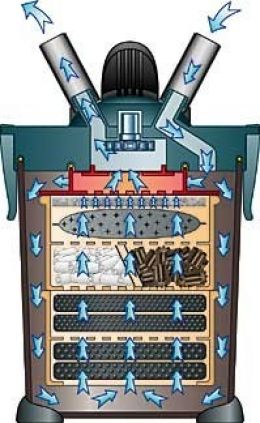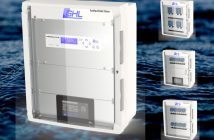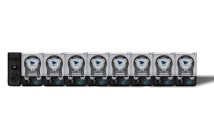I would like to get back to the basics of saltwater aquarium husbandry and focus on the equipment we use on a daily basis. To start the discussion, I would like to bring attention to canister filters. These filters are used by saltwater aquarists on a regular basis. The users of these products are typically new to the hobby, or not quite as hardcore as the typical reef keeper. Despite the best efforts of companies like Fluval, the canister filter is quickly becoming a thing of the past, at least in the reef aquarium realm. With protein skimmers dominating the market, canister filters are no longer vital to have on a reef aquarium, though there are still some benefits to their use.
The filter’s operation is simple. A pump draws in aquarium water, pushes it through several forms of media, then back into the aquarium. Some come with flow meters, digital readouts, and even computers. However, most of the canister filters the typical aquarist will encounter are much less sophisticated.
Continue reading below for the pros and cons of the typical canister filter.
Pros:
Canister filters do have several benefits. For one, they are continually removing larger particles from the water. Aquarium water typically hits the filter foam (or even floss) first. This material traps particles of various sizes before the water reaches later stages of the filter. Activated carbon is another media commonly used, and it is a great tool for any aquarium. Carbon traps organic molecules and other chemicals in its pores, effectively removing them from the water. Another benefit to using canister filters is that they are relatively inexpensive, and if maintained properly, will work well on most aquarium setups (the key to these working well is to stay on top of maintenance). Lastly, the media in the filter will build up colonies of bacteria. This amount is relatively small when compared to populations formed on the sand and live rocks, but it’s added nitrifying bacteria nonetheless.
Cons:
Now to the bad news, and it gets pretty bad. Canister filters clog very easily. Since the pumps are forcing water through different media, flow rates can drop off severely if the filters aren’t cleaned or changed out regularly. Maintenance on canister filters, as with all other aquarium equipment, is key to their success. But the major drawback to canister filter maintenance is that it doesn’t just involve a simple rinsing. You have to break down the entire device, remove all of the filter media, then add brand new media. The replacement media, though not expensive, does add up in extra costs over time.
The previously mentioned drawbacks can be overlooked by most, but this next one is the proverbial nail in the coffin, at least from my standpoint. The dirty filters within the canister aren’t actually removing anything from the water. Yes, the tank water is getting filtered, but the accumulating waste is still decaying within the canister filter. This will still cause a release of unwanted nitrates, phosphates, and many other “nutrients” back into your aquarium. So unless you are routinely breaking down the canister filter and replacing the media, the canister filter is really doing nothing for the water quality. This is why most reef keeper use protein skimmers instead. The skimmer will physically relocate unwanted organic matter into a separate container, where it can no longer come in contact with the aquarium water (barring any accidents of course).
I’m not telling people not to use canister filters. In fact, they can be a great tool when rearranging rock work or shuffling things around that could stir up detritus. However, I wouldn’t personally use on on my reef tank, especially long-term. And having said all of this, a canister filter is better than nothing. So if you already have a canister filter and either don’t have a sump/refugium where you could house a protein skimmer or simply can’t afford to ditch the equipment you already have in favor of something new, just stick with what you have. But I would be on the lookout for some better equipment for the long term health and stability of your aquarium.







